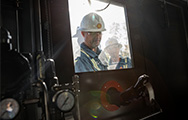Greenhouse gas emissions
We are taking action to manage the emissions from our own operations and the emissions from the energy we use in our operations.
Improving the energy efficiency of our facilities is one of the ways to help us achieve our Net Carbon Footprint ambition to cut the intensity of the greenhouse gas (GHG) emissions of the energy products we sell by around half by 2050, in step with society’s progress to align with the goal of the Paris Agreement.
We require projects and facilities that produce more than 50,000 tonnes of GHG emissions a year to have a GHG and energy management plan in place.
These plans help drive our emissions performance through various actions. This includes using more energy-efficient equipment, installing power from renewable sources and considering carbon capture and storage in the design of our new and largest projects.
GHG and energy management plans must include the sources of GHG emissions, as well as a forecast of expected emissions at the site for at least 10 years. Projects under development that are expected to have a material GHG footprint must meet carbon performance standards or industry benchmarks.
During development, projects are expected to evaluate relevant low-carbon technologies and options to remove GHG emissions. To assess the resilience of proposed projects, we consider factors such as potential costs associated with operational GHG emissions.
We use estimates of future carbon costs that are specific to each country. This is an important part of our efforts to stay in step with society’s progress toward the goals of the Paris Agreement. These estimates were developed using the current Nationally Determined Contributions (NDCs) submitted by countries as part of the Paris Agreement. By 2050, our estimates for all countries increase to $85 a tonne of GHG emissions.
They are the first NDCs under the Paris Agreement and are scheduled to be revised every five years. Therefore, as countries update their NDCs, we expect to update our estimates too. Accordingly, we believe they are a more accurate reflection of society’s current implementation of the Paris Agreement. The UN believes the current NDCs are consistent with limiting the average global temperature rise to around three degrees Celsius above pre-industrial levels. In coming decades, we expect countries to tighten these NDCs to meet the goals of the Paris Agreement.
We have also developed and implemented a comprehensive CO2 and energy management information system that supports our facilities, for example, by analysing real-time data to highlight maintenance gaps and monitor performance.
Greenhouse gas emissions performance
Our direct GHG emissions decreased from 71 million tonnes of CO2 equivalent in 2018 to 70 million tonnes of CO2 equivalent in 2019. The main reasons for the decrease were divestments (for example, in Argentina, Canada, Iraq, Malaysia, Norway and the UK). These decreases were partly offset by the start-up of the Prelude floating liquefied natural gas facility in Australia.
Direct greenhouse gas emissions
million tonnes CO2 equivalent
Enlarge imageDirect and indirect GHG emissions from energy use changes in 2019 [A]
million tonnes CO2 equivalent
[A] Direct and indirect GHG emissions from imported energy from 2018 to 2019
[B] Total greenhouse gas emissions are rounded to the nearest million
[C] Does not include around 1 million tonnes of CO2 captured and sequestered by our Quest CCS project in Canada in 2019
 Climate change
Climate change
 Sustainable development goals
Sustainable development goals
 Safety
Safety
 About our data
About our data
